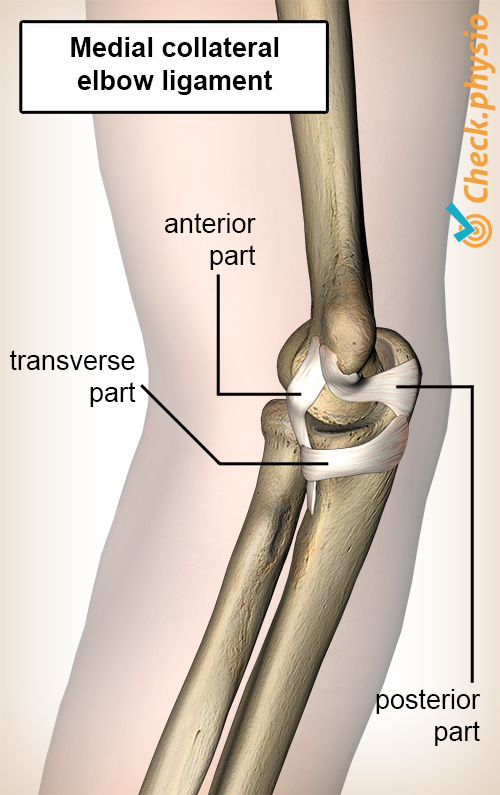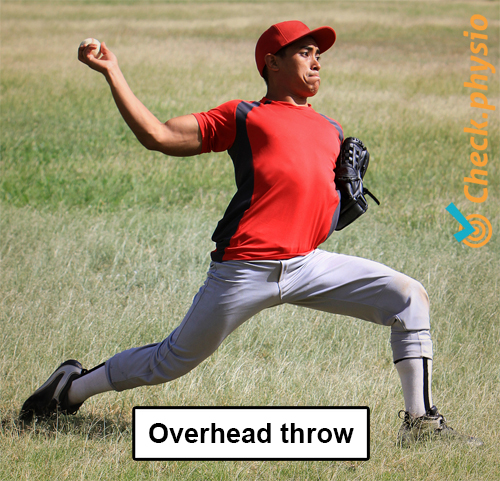- Conditions
- Medial collateral ligament injury elbow
Medial collateral ligament injury elbow Ulnar collateral injury
Introduction
There are several ligaments around the elbow that provide the joint with stability. An injury to the medial collateral ligament of the elbow is characterized by pain and a feeling of instability on the inside of the elbow.
Pain on the inside of the elbow occurs regularly. The symptoms develop mainly when the elbow is in extreme positions. Injury to the medial collateral ligament is therefore often seen in people who practice sports involving (overarm) throwing.

Description of condition
The elbow contains two joints that together form the elbow joint. Thanks to these two joints the elbow can bend and extend and we can rotate our forearm. The forearm contains two bones; the ulna and the radius. The medial collateral ligament of the elbow connects the bone of the upper arm to the ulna.
Various structures around the elbow provide stability and control to the joint during movement. The stability of the elbow joint comes 50% from the bone structures themselves. The remaining stability is provided by the joint capsule, the medial collateral ligament and the lateral collateral ligament.
The medial collateral ligament is also called the ulnar collateral ligament by physicians. The ligament consists of 3 smaller bundles that provide lateral stability to the inside of the elbow. The ligament mainly provides stability during throwing movements or other overhead sporting activities.
Pain develops on the inside of the elbow particularly when the medial collateral ligament is strained too often or too severely. For this reason, the injury is sometimes referred to as elbow overload syndrome.
Cause and history
A medial collateral ligament injury is often the result of repeated overhead throwing. The injury is therefore typical for baseball players, but also occurs in other overhead sports. For example, in tennis, softball and handball.
Incorrect technique, reduced flexibility and training that progresses too fast are the main causes of strain to the inside of the elbow.
The bony structures of the joint between the upper arm and the ulna only provide stability during a small portion of movement. Namely, only around the end-of-range positions, between 0 and 20 degrees, and above 120 degrees flexion of the elbow. When throwing using the right technique, the elbow is usually bent through 100 degrees, so that much of the stability has to come from the ligaments and muscles.
Through frequent throwing, laxity (slackness) of the ligament may develop which creates instability in the elbow joint. In addition, when the elbow is extended during the last phase of the throw, enormous forces are exerted on the inside and the back of the elbow.
Laxity in the medial collateral ligament and not moving properly may cause tissue to be trapped at the back of the elbow. This is called an impingement.
Symptoms on the inside of the elbow can develop either gradually or acutely. If the symptoms are acute, a snap is usually felt in the elbow. This is immediately followed by a lot of pain and it is no longer possible to continue playing sports.
Signs & symptoms
The main symptom is pain on the inside of the elbow. In addition, overhead athletes often have symptoms during a certain part of the trajectory of an overhead movement. For example, while throwing or serving in tennis.
After a prolonged period of instability, pain may also occur when extending the elbow. This pain is then often experienced as very sharp and painful, and is usually caused by the impingement.
As well as pain, swelling and discoloration may occur on the inside of the elbow. Swelling and discoloration are particularly evident in acute injuries. Athletes also often notice a loss of coordination or strength during specific movements.
Diagnosis
The physiotherapist makes the diagnosis based on question and answer, and a physical examination. The physical examination is mainly aimed at checking whether there the joint ligaments on the inside of the elbow are unstable.
In the cases of an acute injury or extreme laxity, medical imaging is usually performed to see if there is a tear or other problem present in the elbow.
Treatment and recovery
Initially, the treatment consists of rest to allow the ligament to recover. Subsequently, the elbow capacity will be built up using exercise therapy.
In addition, corrections to technique may be applied. This can be improved by functional training which provides a gradual build-up to a return to sport. During therapy, the patient will be advised on the correct way of stepping up the training so that a future recurrence of the injury can be prevented.
Exercises
Take a look at the exercise program with exercises for the inner ligament injuries of the elbow.
More info
You can check your symptoms using the online physiotherapy check or make an appointment with a physiotherapy practice in your locality.
References
Chen, F.S., Rokito, A.S. & Jobe, F.W. (2001) Medial elbow problems in the overhead-throwing athlete J Am Acad Orthop Surg. Vol 9, No 2, March/April 2001.
Magee, D.J., Zachazewski, J.E., Quillen, W.S., Manske, R.C. (2016) Pathology and intervention in musculoskeletal rehabilitation Elsevier, 2nd edition.

